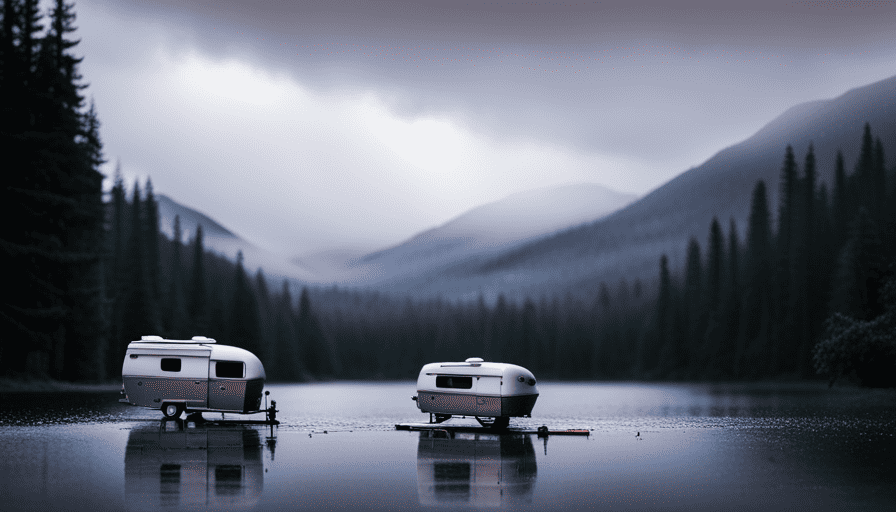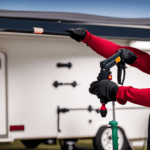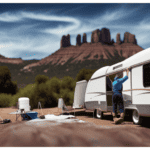So, you have decided to embark on a camping adventure, only to find out there is a leak in the roof of your camper. What a way to start your wilderness getaway, huh? But fear not, my fellow nature lovers, because I am here to assist you. In every possible way, I’ve got you covered.
In this article, I’ll share my knowledge and experience on how to fix camper roof leaks. Trust me, I’ve been there, done that, and managed to keep my camping trips rain-free. With a little bit of elbow grease and the right tools, you’ll be able to patch up those pesky leaks and enjoy a leak-free camping experience.
First things first, we need to identify the source of the leak. Once we’ve pinpointed the problem areas, we’ll gather our tools and materials and get to work.
From cleaning and preparing the roof surface to applying roof sealant and inspecting and repairing any damaged roofing materials, I’ll walk you through each step of the process.
So, let’s get started and make sure those leaks become nothing more than a distant memory. Get ready to tackle those roof leaks head-on and enjoy the great outdoors without having to worry about getting wet.
Key Takeaways
- Identifying the source of the leak is crucial for fixing camper roof leaks.
- Regular inspection and maintenance routine is necessary to prevent future leaks.
- Choosing the right sealant and applying it correctly is essential for a watertight seal.
- Reinforcing vulnerable areas with roofing tape can effectively waterproof the camper roof.
Identify the Source of the Leak
Now, you need to start by examining your camper roof closely to identify the exact source of the leak. It’s important to catch the problem early on before it leads to further damage or costly repairs.
There are a few common signs that can help you pinpoint where the leak is coming from. Look for water stains or discoloration on the ceiling or walls inside your camper. Check for any soft spots or sagging areas on the roof itself. Another clue may be the presence of mold or mildew, indicating a moisture issue.
Once you have identified the source of the leak, it’s time to take preventive measures to avoid future leaks. Regularly inspect your roof for any signs of damage or wear and tear, such as cracked sealant or loose screws. Clean your roof regularly and remove any debris that could cause water to pool and potentially lead to leaks. By being diligent in your maintenance routine, you can prevent roof leaks and ensure the longevity of your camper.
Now, let’s move on to the next step of gathering the necessary tools and materials.
Gather the Necessary Tools and Materials
First, you’ll need to gather all the essential tools and materials to tackle this issue with your camper’s roof. Here’s a list of items you’ll need:
-
Sealant: Choose the right sealant, specifically designed for RV roofs, as they’re more durable and weather-resistant. Silicone-based or elastomeric sealants are excellent choices.
-
Caulking gun: Get a high-quality caulking gun that allows for precise control to apply the sealant smoothly and evenly.
-
Putty knife: Use a putty knife to remove any old sealant or debris from the roof surface. This ensures a clean and smooth surface for the new sealant application.
-
Clean cloth or sponge: Before applying the sealant, thoroughly clean the roof surface. Use a clean cloth or sponge to remove any dirt, dust, or loose particles. This helps the sealant adhere better to the roof.
Choosing the right sealant and using proper application techniques are crucial for a successful roof repair. Once you’ve gathered all the necessary tools and materials, you can proceed to clean and prepare the roof surface for the next step.
Clean and Prepare the Roof Surface
To ensure a successful repair, you’ll want to start by thoroughly cleaning and preparing the surface of your camper’s roof, creating a smooth and debris-free foundation for the next step. Proper roof cleaning and preparation are crucial for a long-lasting fix. Not only will it remove dirt, grime, and other contaminants, but it will also ensure better adhesion of the sealant to the roof surface.
Before you begin the cleaning process, gather the necessary tools and materials mentioned in the previous subtopic. Once you have everything ready, follow these steps to clean and prepare your camper’s roof:
- Start by sweeping the roof surface to remove loose debris, such as leaves and twigs.
- Use a hose or pressure washer to rinse off any remaining dirt and debris.
- Apply a roof cleaner specifically designed for your camper’s roof material. Follow the manufacturer’s instructions for dilution and application.
- Scrub the roof surface using a soft-bristle brush or a mop. Pay extra attention to areas with stubborn stains or mold.
- Rinse off the cleaning solution thoroughly with clean water.
By properly cleaning and preparing the roof surface, you’ll create an optimal environment for the next step, which is applying roof sealant to the leaky areas. This will effectively prevent any further leaks and ensure the longevity of your camper’s roof.
Apply Roof Sealant to the Leaky Areas
Ensure a long-lasting solution by applying roof sealant to the problem areas, providing a watertight seal that keeps your camper dry and protected. Roof sealant application is a crucial step in preventing roof leaks and maintaining the integrity of your camper.
Before applying the sealant, make sure the roof surface is clean and free of any dirt, debris, or loose materials. This will ensure proper adhesion and maximize the effectiveness of the sealant.
To apply the roof sealant, start by identifying the areas where leaks are occurring. Use a caulk gun to apply a generous amount of sealant directly onto the leaky spots. Make sure to cover the entire area with a smooth and even layer of sealant. Pay extra attention to any seams, vents, or damaged areas on the roof, as they’re common areas for leaks to develop.
After applying the sealant, allow it to dry completely before moving on to the next step. This will ensure that the sealant forms a strong and durable bond with the roof surface. Once the sealant is dry, it’ll create a protective barrier that prevents water from seeping into your camper.
To inspect and repair any damaged roofing materials, carefully examine the roof surface for any signs of cracks, holes, or loose shingles. Address any issues promptly to prevent further damage and potential leaks.
Inspect and Repair any Damaged Roofing Materials
After applying the roof sealant, it’s important to carefully examine the roof surface for any signs of damage and promptly address any issues. This step is crucial for ensuring proper roof leak prevention and maintaining a watertight camper. Here are some key points to consider:
-
Inspect the roof for any visible signs of water damage, such as discoloration, sagging, or soft spots. Pay close attention to seams, vents, and any other areas where water may be more likely to penetrate.
-
Check for any loose or missing roofing materials, such as shingles or tiles. These can create openings for water to seep in and cause leaks.
-
Look for cracks or holes in the roof surface. Even small openings can allow water to infiltrate and lead to significant damage over time.
By thoroughly examining the roof and addressing any damaged areas, you can prevent future leaks and maintain the integrity of your camper’s roof. Once you have identified and repaired any issues, you can move on to reinforcing vulnerable areas with roofing tape.
Now, let’s move on to the next step and reinforce vulnerable areas with roofing tape.
Reinforce Vulnerable Areas with Roofing Tape
Guard your camper against potential vulnerabilities by reinforcing weak areas with the protective shield of roofing tape. Camper roof maintenance is crucial in ensuring the longevity of your vehicle.
Over time, the roof can develop cracks, gaps, or other weak points that can lead to water leaks. To prevent this, waterproofing techniques such as using roofing tape can provide an effective solution.
Roofing tape is a versatile tool that can be used to reinforce vulnerable areas on your camper’s roof. It’s made of a durable and waterproof material that adheres firmly to the surface, creating a barrier against water infiltration. Before applying the tape, thoroughly clean and dry the area to ensure proper adhesion. Then, simply peel off the backing and carefully press the tape onto the vulnerable area, ensuring full coverage.
Pay close attention to areas where previous leaks have occurred or where the roofing materials are showing signs of wear and tear. These are often the most vulnerable areas and should be reinforced with roofing tape as a proactive measure. Additionally, consider applying the tape along seams, edges, and around any roof-mounted fixtures to provide extra protection.
By reinforcing weak areas with roofing tape, you can effectively safeguard your camper against potential roof leaks. Once the repairs have been made, it’s important to test their effectiveness. Transitioning into the subsequent section about testing the repairs for effectiveness, it’s crucial to ensure that the reinforced areas are watertight and able to withstand various weather conditions.
Test the Repairs for Effectiveness
To make sure your repairs are working effectively, give them a thorough test to ensure your camper stays dry in any weather conditions. Testing the repairs is crucial to avoid any surprises when you’re out on the road. Here are three testing methods to evaluate the effectiveness of your fixes:
-
Water Hose Test: Grab a water hose and simulate heavy rain by directing the water onto the repaired areas. Pay close attention to any signs of leakage or water penetration. This test will help you identify any remaining weak spots that need further attention.
-
Moisture Meter Test: Invest in a moisture meter specifically designed for campers. This handy device detects any hidden moisture within the repaired areas. By using the meter, you can pinpoint any areas that may still be prone to leaks and address them promptly.
-
Real-world Rain Test: The ultimate test is taking your camper out for a trip during a rainy period. Expose your repairs to the actual weather conditions to see how well they hold up. This real-world test will give you the confidence to trust your repairs and enjoy your camping adventures without worrying about leaks.
By thoroughly testing your repairs using these methods, you can ensure that your camper roof is in top shape. Moving forward, it’s crucial to maintain regular roof inspections and maintenance to prevent any future leaks.
Maintain Regular Roof Inspections and Maintenance
Regularly inspecting and maintaining your camper roof ensures its longevity and guarantees worry-free camping adventures. By conducting regular roof inspections, you can identify any signs of damage or potential leaks early on, allowing you to take preventive measures before they become major issues. This will save you time and money in the long run.
To help you understand the importance of regular maintenance, here is a table summarizing the key preventive measures you should take:
| Preventive Measures | Frequency | Actions |
|---|---|---|
| Clean debris | Monthly | Remove leaves, branches, and other debris from the roof. |
| Check seals | Annually | Inspect all seals around vents, skylights, and antennas for cracks or gaps. Replace if necessary. |
| Apply sealant | Every 2-3 years | Reapply sealant to seams, edges, and penetrations to maintain waterproofing. |
Regular maintenance not only prevents leaks but also extends the lifespan of your camper roof. It ensures that your camping trips remain enjoyable and worry-free, without the stress of unexpected leaks ruining your adventures.
Considering professional help for complex leaks is important. While regular maintenance can address most issues, some leaks may require the expertise of a professional. They have the knowledge and experience to tackle complex leaks and ensure a proper repair.
Transitioning into the subsequent section about professional help: If you encounter a leak that goes beyond your DIY skills, it’s essential to consider seeking professional assistance for a thorough and effective repair.
Consider Professional Help for Complex Leaks
Seeking professional assistance is crucial when dealing with intricate leakage issues that may require specialized expertise. While some camper roof leaks can be fixed with DIY options, there are situations where it’s best to call in the professionals.
Professional roof inspections offer several benefits that can help you address complex leaks effectively. Firstly, professionals have the knowledge and experience to identify the root cause of the leak. They can thoroughly assess your camper’s roof, detecting any underlying issues that may be contributing to the leakage problem. This comprehensive examination ensures that all potential sources of leaks are identified and addressed.
Additionally, professional roof inspections provide a detailed assessment of your camper’s roof condition. They can spot signs of wear and tear, structural damage, or improper installations that might be causing leaks. By addressing these issues promptly, you can prevent further damage and costly repairs in the future.
Furthermore, hiring professionals ensures that the repairs are done correctly. They have the necessary tools and materials to fix the leaks effectively, using techniques that’ll provide long-lasting results. Their expertise guarantees that the job is done right the first time, saving you time, effort, and frustration.
By considering professional help for complex leaks, you can rest assured that your camper’s roof is in good hands. With their assistance, you can enjoy a leak-free camping experience, knowing that your roof has been thoroughly inspected and any issues have been properly addressed.
Enjoy a Leak-free Camping Experience
Ensure that your camping experience remains hassle-free by enjoying a leak-free adventure with a properly maintained and inspected RV. To prevent water damage and maximize camping comfort, there are a few steps you can take.
First and foremost, regularly inspect your camper roof for any signs of leaks or damage. Look for cracks, tears, or loose seams that could potentially allow water to seep in. If you notice any issues, it’s important to address them promptly to avoid further damage. You can use a sealant or roof tape to patch up small cracks or gaps.
Additionally, keeping your camper roof clean and free from debris is crucial in preventing leaks. Leaves, sticks, and other debris can clog up your RV’s gutters and drains, causing water to pool and potentially seep into your camper. Regularly clean your roof and make sure the gutters are clear.
Investing in a high-quality RV cover is another effective way to protect your camper from leaks. A good cover will not only shield your RV from the elements but also prevent water from seeping through the roof.
By following these tips and taking proactive measures, you can ensure a leak-free camping experience, preventing water damage and maximizing your camping comfort. Stay dry and enjoy your adventures!
Frequently Asked Questions
How long does it typically take to fix a camper roof leak?
On average, fixing a camper roof leak typically takes a few hours to a couple of days, depending on the severity of the damage. The best methods for repairing a camper roof leak involve thoroughly inspecting the roof for any cracks or gaps, cleaning and drying the area, applying a high-quality sealant, and ensuring a proper seal.
It’s important to address the issue promptly to prevent further damage and ensure a watertight seal for your camper roof.
Can I use any type of roof sealant for the repairs?
Yes, it’s important to use the right type of roof sealant for camper repairs. There are different types available, such as silicone, urethane, and acrylic sealants. Each has its own advantages and suitability for specific situations. Proper application techniques are crucial for a successful repair. It’s important to clean and prepare the surface before applying the sealant, ensuring it’s evenly spread and covers the damaged area completely.
Are there any specific tools or materials that should be avoided when fixing a camper roof leak?
When it comes to fixing a camper roof leak, it’s important to steer clear of certain tools and materials that can do more harm than good.
One thing to avoid like the plague is silicone sealant, as it tends to create a messy and ineffective patch.
Additionally, be wary of using improper adhesives, as they may not provide the necessary durability to withstand the elements.
Stick to the right tools and materials to ensure a successful repair job.
What are some common signs of a camper roof leak that may not be immediately noticeable?
Some common signs of a camper roof leak that may not be immediately noticeable include water stains or discoloration on the ceiling or walls, a musty odor, and warped or soft areas on the camper’s interior.
These signs indicate that water has penetrated the roof and is causing damage. It’s important to address these signs promptly to prevent further damage and ensure effective roof leak prevention.
Is it necessary to inspect and repair the interior of the camper if a roof leak has occurred?
If a roof leak has occurred in your camper, it’s absolutely necessary to inspect and repair the interior. Interior damage can be just as detrimental as external leaks, leading to mold, rot, and structural issues.
To prevent further damage, it’s crucial to identify any signs of water infiltration, such as stained ceilings or walls, musty odors, or soft spots in the flooring. Promptly addressing these necessary repairs will help maintain the integrity of your camper and ensure a safe and comfortable camping experience.
Are the Steps to Fix Camper Roof Leaks the Same for All Types of Leaks?
When it comes to fixing camper roof leaks, the steps may vary depending on the type of leak. Identifying the cause is crucial before proceeding with repairs. For minor cracks or punctures, sealing them with a specialized patch or tape can be effective. Leaks around vents or vents may be resolved by resealing them. However, for more significant damage like structural issues, it is advisable to consult a professional for proper repairs.
Conclusion
After following these steps, you’ll be amazed at the transformation of your camper roof. No longer will you have to worry about pesky leaks ruining your camping trips.
With a little bit of effort and the right materials, you’ve successfully fixed those annoying leaks and created a watertight roof. Now you can enjoy your camping experience without any unwanted surprises.
So go ahead, hit the road, and bask in the glory of a leak-free camper roof. Happy camping!



















